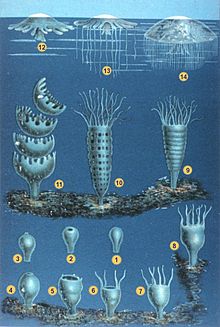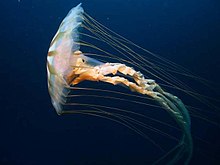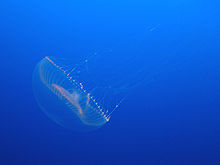jellyfish

Compass jellyfish ( Chrysaora melanaster )
|

Ear jellyfish ( Aurelia aurita )
|

Fried egg jellyfish ( Cotylorhiza tuberculata )
|

Dotted root mouth jellyfish ( Phyllorhiza punctata )
|
|
|
A jellyfish , also called Meduse or Medusa (Pl. Medusen; Medusae) in scientific parlance , denotes a stage of life of cnidarians (Cnidaria). Jellyfish are not a systematic - taxonomic group.
The term is also used for the rib jellyfish (Ctenophora). Earlier ctenophora were asked to cnidarians or by cnidarians as Hohltiere summarized (coelenterates). Today the rib jellyfish are considered a separate animal strain that is probably not closely related to the cnidarians.
Most species with a jellyfish stage live in the sea. But there are also a few species of freshwater jellyfish , one of which, brought in from Asia, is now also at home in German waters. The native freshwater polyps , on the other hand, do not have a medusa stage.
Jellyfish in the life cycle
A generation change is typical for many cnidarians , in which a stuck stage, called a polyp , and a freely swimming medusa or jellyfish stage alternate regularly, called metagenesis . The polyp produces in an asexual way, e.g. B. by sprouting (sometimes called strobilation ) free-swimming medusas, which through sexual reproduction (via germ cells) form a larva, the planula , which attaches itself and differentiates again into a polyp. Thus, the free-swimming jellyfish stage is only part of the complex life cycle of the corresponding type. It is often difficult and time-consuming to identify the belonging to a jellyfish polyps generation that often erroneously as a separate species described has been.
The life cycle mentioned is typical for cnidarians of the classes Scyphozoa (umbrella jellyfish), Cubozoa (box jellyfish) and Hydrozoa . The Anthozoa never have a jellyfish stage. The generation change in many species has also been modified for the classes mentioned, in some species one of the stages (jellyfish or polyp) has been lost. There are also a few species of jellyfish that do not have a polyp stage.
anatomy
Jellyfish have a flattened umbrella-like structure with a hanging stomach stem ( manubrium ), on the underside of which there is a mouth opening. They consist mainly of two single layer just under a fifty millimeter thick Gewebslagen ( epithelia ) of the outer skin (exodermis or epidermis) and the stomach cavity lining inner skin (endodermis or gastrodermis) between which a predominantly cell-free layer, the mesoglea is located, . This is gelatinous , so that the entire organism consists of around 98 to 99 percent water . Jellyfish have about the same density as the surrounding water. A central gastric cavity is embedded in the mesogloea, from which coat pockets or radial channels originate, which in many species are connected to an annular channel on the outside of the umbrella. Some species have eyes ( ocelles ) and sensory organs ( statocysts ) on the edge of the screen . In addition, the gonads ( gonads ) are often colored inside . Jellyfish are usually of separate sexes, so there are male and female specimens.
Most jellyfish have long tentacles that are equipped with nettle cells . They use these to catch prey and for defense. These nettle cells are scattered over the tentacles and form a poisonous secretion . If the cnidocil (a stalk-shaped extension of the nettle cells) comes into contact , the nettle capsule inside the nettle cell bursts open at a pressure of 150 bar and turns a nettle thread outwards, which at the same time releases the paralyzing poison contained in the nettle capsule. Usually the nettle thread is also covered with spikes. After use, the nettle capsules are shed and replaced with newly formed ones.
Locomotion
Jellyfish swim through a contracting movement of their umbrella, in which they eject water downwards according to the principle of recoil . The recoil creates a propulsion, even if the same amount of water is sucked in during the suction process. This is due to the fact that it is directed backwards quickly and like a jet, while the incoming water is sucked in slowly and non-directionally. With this principle, they can travel up to ten kilometers per hour. Jellyfish are unable to swim long distances against a current of water. Despite their size, they are therefore counted among the plankton . Together with the comb jellyfish, they form their own category, the "gelatinous" plankton.
Lifestyle and diet
Jellyfish are an essential part of the free water ( pelagial ) community of the oceans. However, researching them is difficult because they tend to multiply irregularly. Since most of the species are predators, they are food competitors of fish species, and some species also feed on fish larvae. Sometimes, for example in the Norwegian Lurefjord , jellyfish-dominated communities form (here the crown jellyfish Periphylla periphylla ), so that fish are almost completely displaced, with drastic consequences for the ecology of the water. But this is the exception. However, it is sometimes feared that humans could shift the balance in favor of the jellyfish through overfishing in other places as well.
Jellyfish feed predominantly carnivorous of zooplankton , especially small crustaceans such as copepods (copepods), protozoa and larvae of other marine organisms; larger species can also prey on larger free-swimming organisms, including fish and other jellyfish. Smaller species and juvenile stages also take in phytoplankton , for example the ear jellyfish Aurelia aurita with an umbrella diameter of around 44 millimeters. The prey killed or stunned by the stinging tentacles is transported to the mouth opening by shortening the tentacles and then devoured.
Jellyfish of the genus Cassiopea can also live in symbiosis with algae, which provide their host with the necessary food.
Fossil jellyfish
It is astonishing and only possible under very special circumstances that soft-skinned organisms such as jellyfish can form fossils at all. Fossil jellyfish are therefore extremely rare and mainly known from two geological ages, the Cambrian and the Carboniferous . Numerous fossils that initially appeared to be jellyfish-like, known as "medusoids", did not turn out to be jellyfish on closer inspection. Their nature is often unclear; some are obviously not even actual fossils, but rather go back to inorganic processes. So all possible jellyfish fossils from the Precambrian were exposed as false. The oldest indubitable fossils come from the third series of the Cambrian, for example the famous deposit of Burgess slate . In the Central Cambrian Marjum Formation in Utah, USA, amazingly well-preserved fossil jellyfish with tentacles and even traces of muscles and gonads have been found. From this time there are already recognizable fossils of all three classes (Cubozoa, Hydrozoa, Scyphozoa), the origin and radiation of which must have been a long time ago. It is possible that the jellyfish also go back to the great radiation at the beginning of the Cambrian ( Cambrian Explosion ).
The freshwater jellyfish Medusina limnica Müller, 1978, Medusina atava (Pohlig, 1898) and Medusina strigillata Müller, 1982 have been identified from the Rotliegend ( Permian ) of Central Europe .
Jellyfish in zoological gardens
Keeping and breeding jellyfish is very time-consuming and difficult, as a water current must always be active in the aquarium. The individual stages of development also require very specific (and mostly different) living conditions, such as water temperature and food supply (plankton). Also, jellyfish usually cannot be kept with other species as they could injure themselves. Jellyfish are therefore only presented in a few aquariums. In April 2006 the amusement and animal park Ocean Park Hong Kong opened the Sea Jelly Spectacular, a special jellyfish house with over 1000 copies.
At the end of 2015, the Schönbrunn Zoo reported on the successful breeding of the rare giant jellyfish Rhizostoma luteum from the Mediterranean.
Jellyfish and humans
In humans, the secretion secreted by the nettle cells usually causes burning pain, reddening of the skin or itchy rashes (blisters, swellings). If left untreated, the effect can be compared to a slight burn ; visible pigment changes or even scars can remain for months . The poison of a few species can cause breathing difficulties, nausea or even circulatory collapse . If the tentacles or parts of them stick to people, they should not be touched with bare hands, as they can still secrete poison for a very long time. Touching stranded jellyfish is also not advisable for the same reason.
Some jellyfish species develop strong nettle activity, which is sometimes life-threatening for humans. These include box jellyfish (Cubomedusae), Solmundella bitentaculata , which attacks fish with its tentacles, and chiropsalmus , whose nettles can cause skin swelling and spasms. The poison of the Australian sea wasp is particularly notorious .
use
science
Jellyfish play an increasingly important role in science. Green fluorescent protein (GFP) from Aequorea victoria , which has played a major role in molecular and cell biology since the mid-1990s, was investigated as early as the 1960s .
Since the BSE problem , jellyfish have also been the focus of research and industry as a supplier of collagen . In addition to its use in cosmetics and plastic surgery , scientists are studying its use as a cartilage replacement for worn joints.
At the end of 2013, mathematicians from New York University presented an ultra-light model aircraft that imitates the movement of jellyfish, the first ornithopter that does not require regulation or aerodynamic stabilization.
Use as food
Especially in Asian cuisine , some non-poisonous jellyfish are prepared and eaten as food. All edible species belong to the root-mouth jellyfish (order Rhizostomae). The following species are used: Family Cepheidae: Cephea cephea (Forskål, 1775). Family Catostylidae: Catostylus mosaicus (Quoy & Gaimard, 1824), Crambione mastigophora Maas 1903, Crambionella orsisi (Vanhöffen, 1888). Family Lobonematidae: Lobonema smithii Mayer, 1910, Lobonemoides gracilis Light, 1914. Family Rhizostomatidae: Rhizostoma pulmo (Macri, 1778), Rhopilema esculentum Kishinouye, 1891, Rhopilema hispidum (Vanhoffen, 1888), Neopilema nomurai Kishinouye, 1922. Family Stomolophidae: Stomolophus meleagris Agassiz, 1862. All of these are large, relatively coarse species with a large umbrella. Dealers and cooks do not differentiate between types, but rather a number of types based on external characteristics, e.g. B. Red or Chinese type, white type, sand type, etc. During the day fishing is done with nets, especially gillnets . The main producers are China, the Philippines, Vietnam, Thailand, Malaysia, Indonesia and Myanmar, the main consumers are Japan and China. For trade and transport, the mouth stalk with the tentacles is removed and the umbrella is drained by placing it in salt. You lose more than 90 percent of your fresh weight. Soak them overnight before making them. The annual harvest is estimated at around 321,000 tons of fresh weight per year.
literature
- Sabine Holst: "Original and fascinating: Jellyfish on the North and Baltic Sea coasts." Biology in our time 41 (4), pp. 240–247 (2011), ISSN 0045-205X
- B. Werner: 4th strain Cnidaria In: Alfred Kaestner (founder): Textbook of special zoology. Volume I: Invertebrates. Part 2: Cnidaria, Ctenophora, Mesozoa, Plathelminthes, Nemertini, Entoprocta, Nemathelminthes, Priapulida. Gustav Fischer Verlag, Jena, 4th edition 1984.
Broadcast reports
- Dagmar Röhrlich : Under jellyfish - encounter with the swarm , Deutschlandfunk - “ Science in focus ” from June 3, 2018
Web links
- Details on jellyfish breeding in the Berlin Aquarium .
- British Marine Life Study Society - Jellyfish Page .
Individual evidence
- ^ A b F. Boero, J. Bouillon, C. Gravili, MP Miglietta, T. Parsons, S. Piraino (2008): Gelatinous plankton: irregularities rule the world (sometimes). Marine Ecology Progress Series Vol. 356: 299-310. doi: 10.3354 / meps07368
- ↑ Lasse Riemann, Josefin Titelman, Ulf Båmstedt: Links between jellyfish and microbes in a jellyfish dominated fjord . In: Inter-Research Marine Ecology Progress Series . tape 325 , November 7, 2006, pp. 29–42 , doi : 10.3354 / meps325029 (English, PDF ).
- ↑ U. Båmstedt: Trophodynamics of the scyphomedusae Aurelia aurita. Predation rate in relation to abundance, size and type of prey organism . In: Journal of Plankton Research . tape 12 , no. 1 , 1990, p. 215–229 , doi : 10.1093 / plankt / 12.1.215 (English, PDF ).
- ↑ Edward A. Drew, The biology and physiology of alga-invertebrate symbioses. I. Carbon fixation in Cassiopea sp. at aldabra atoll , Journal of Experimental Marine Biology and Ecology, 1972
- ^ Graham A. Young & James W. Hagadorn (2010): The fossil record of cnidarian medusae. Palaeoworld 19: 212-221. doi: 10.1016 / j.palwor.2010.09.014
- ^ Paulyn Cartwright, Susan L. Halgedahl, Jonathan R. Hendricks, Richard D. Jarrard, Antonio C. Marques, Allen G. Collins, Bruce S. Lieberman (2007): Exceptionally Preserved Jellyfishes from the Middle Cambrian. PLoS ONE 2 (10): e1121. doi: 10.1371 / journal.pone.0001121 (open access)
- ↑ Heinz Kozur: The spread of the limnic medusa Medusina limnica Müller 1978 in the red-lying Central Europe. Paläontologische Zeitschrift, 58 (1/2): 41-50, Stuttgart, 1984 doi: 10.1007 / BF02990326
- ↑ http://wien.orf.at/news/stories/2748622/ Schönbrunn breeds giant jellyfish, orf.at December 21, 2015, accessed December 21, 2015.
- ↑ Interview with Martin Chalfie . in-cites. December 2002.
- ↑ B. Steipe, A. Skerra: GFP: The Green Fluorescent Protein ( Memento of the original from December 20, 2008 in the Internet Archive ) Info: The archive link was inserted automatically and has not yet been checked. Please check the original and archive link according to the instructions and then remove this notice. . Based on an article in: Biospectrum . Vol. 3, No. 1, 1997, pp. 28-30.
- ↑ Press release University of Lübeck. April 27, 2009
- ^ I. Niermann: Jellyfish as synovial fluid . In: stern . September 15, 2007.
- ↑ Deutschlandfunk , Research News , January 15, 2014: deutschlandfunk.de: Researchers build a flying jellyfish
- ^ Makoto Omori & Eiji Nakano (2001): Jellyfish fisheries in southeast Asia. Hydrobiologia 451: 19-26. Online version at Sea-Ex Trade-Seafood Fish Directory









